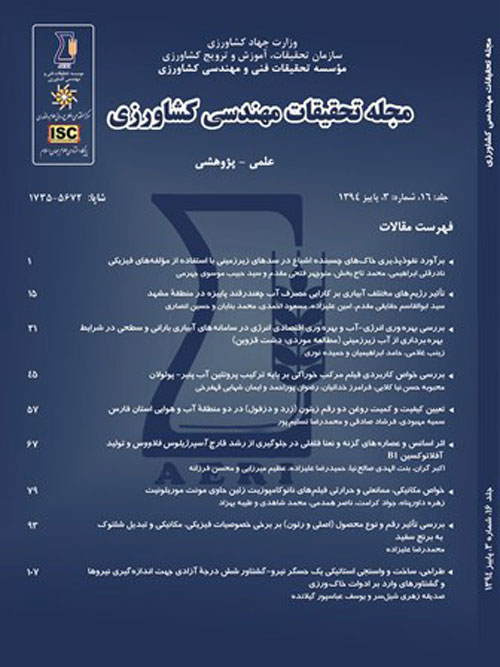Determination of Quality and Quantity of Olive Oil from Zard and Dezful Cultivars in two Climatic Regions in Fars Province, Iran
Author(s):
Abstract:
Knowledge of the attributes of a cultivar is important to selection of the appropriate cultivar for modern olive culture. These include productivity, resistance to pests and natural conditions, high oil content, oil quality, size and shape of fruit, and high proportion of meat to core. The type and amount of fatty acid in olive oil determines its quality and the economic value of the oil. The composition of olive is significantly affected by the cultivar and climatic conditions. The present study determined the physical and chemical characteristics of olive and olive oil extracted from two Iranian varieties of olive (Zard and Dezful), bothgrown in the regions of Shiraz and Kazeroon, two major olive producing areas in Fars province. After determining the physical characteristics of the fruit, the olive oil was mechanically extracted. Physical characteristics of the fruit (weight, density, length, diameter of fruit and core, and meat-to-core ratio) were recorded. The fatty acid composition of the oil was determined by gas chromatography. The results showed that the physical and chemical properties of both cultivars were in accordance with national and international standards. The Dezful cultivar showed a longer length of core, but there were no significant differences between cultivars for other physical characteristics. The length of fruit in Shiraz and the meat-to-core ratio was higher than offruit in Kazeroon. There was no significant differencesbetween areas for the other physical characteristics. The biochemical indicators between cultivars indicated that the oleic, stearic, and arachidic acid content of the Zard cultivar was higher than for the Dezful cultivar and the palmitic, palmitoleic, and linoleic acid content of the Dezful was higher than the Zard. There was a positive correlation between oleic acid content and temperature. Shiraz olives had the highest oil and oleic acid contents and the linoleic acid, palmitic, and palmitoleic acid content ofKazeroon oliveswere higher. The Zard cultivar in Shiraz had the highest oleic acid content.The superior quality of the Zard cultivar in Shiraz, which had the highest oleic acid content (74.2%) and lowest linoleic acid content, recommends it as the best variety. These results indicate that the quality of the olive oil depends both on the olive cultivar and the geographical location.
Keywords:
Language:
Persian
Published:
Journal of Agricultural Engineering Research, Volume:16 Issue: 3, 2015
Pages:
57 to 66
magiran.com/p1478158
دانلود و مطالعه متن این مقاله با یکی از روشهای زیر امکان پذیر است:
اشتراک شخصی
با عضویت و پرداخت آنلاین حق اشتراک یکساله به مبلغ 1,390,000ريال میتوانید 70 عنوان مطلب دانلود کنید!
اشتراک سازمانی
به کتابخانه دانشگاه یا محل کار خود پیشنهاد کنید تا اشتراک سازمانی این پایگاه را برای دسترسی نامحدود همه کاربران به متن مطالب تهیه نمایند!
توجه!
- حق عضویت دریافتی صرف حمایت از نشریات عضو و نگهداری، تکمیل و توسعه مگیران میشود.
- پرداخت حق اشتراک و دانلود مقالات اجازه بازنشر آن در سایر رسانههای چاپی و دیجیتال را به کاربر نمیدهد.
In order to view content subscription is required
Personal subscription
Subscribe magiran.com for 70 € euros via PayPal and download 70 articles during a year.
Organization subscription
Please contact us to subscribe your university or library for unlimited access!


